With the design bug deeply embedded and noshing on my brain juices, I started working on the main concepts for my monster hunting game. Back in the early years of attending Gen Con, I frequently attended the convention’s various design seminars and starting all this pulls up memories from more than a decade ago. It was a fun time of doing my own designs that never seemed to go anywhere but were completed all the same. I envision a similar fate to this venture but this is one of the few exceptions where I enjoy the journey more than the destination.
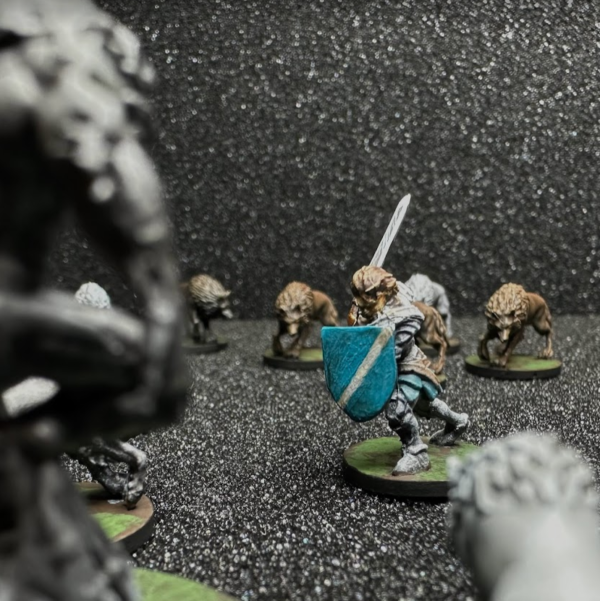
Conceptually, I want the game to have the classic dual game campaign feel. The first part will be the management, prep, and growth of the hero and his keep. The second part will be the dynamic and epic battle where the hero goes up against the monster. Because this second part is the most important part of the game, I want to focus on it first to make that as solid as possible before working on how the hero should grow and evolve over the course of the game.
Because the game will focus on a single hero controlled by the player, you can make the options more complicated than a game where the player has to split focus on multiple characters. This is why your role playing character can have tons of stats and effects listed over multiple pages as opposed to a miniatures game like Infinity where a unit has a compressed stat block.


That being said, I’m not interested in making something as complex as a role playing game. Infinity is a very complex game as well and I’m not looking for that level of complexity either but want to make the character more than just a group of stats that you reference and look up effects for.
To do that, I wanted to explore the idea of managing the character’s ability to interact with the world in a dynamic ways. I saw this concept first in the first and second edition of the Batman Miniatures Game where you had key stats and a set of resources that you used to program your actions for the upcoming round. While I haven’t played it, I imagine similar systems exist in games like Battletech where you manage all the aspects of the mech like heat, fuel, ammo, etc.

I’m a firm believer of getting to the test phase as soon as possible to test concepts and mechanics and see how they interact. Evaluating how it feels to play with the mechanics and discover the good and bad interactions is key to moving forward. Above is my take on this dynamic action-allocation system. In the example I have, it isn’t pretty nor geared to good UI design but it allowed me to print out something quickly and start seeing how stuff works.
This design took several iterations before I even took it to the table as I had to work out what core stats I wanted to represent in the game, what basic action options should be available, and how this could all interact as an operational system.
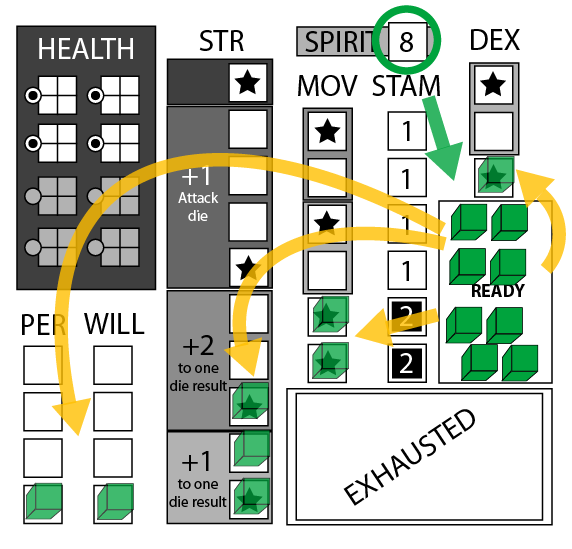
I won’t go into all the details yet but idea is that you will have X resource tokens (the green cubes above) to use throughout the battle. This is based on the character’s “Spirit” value above. At the start of the battle, you are fresh and ready so all your cubes start in the “Ready” zone. At the start of the round, you allocate these cubes to different abilities and stats on your board. This will dictate what you will do on your turn for this round.
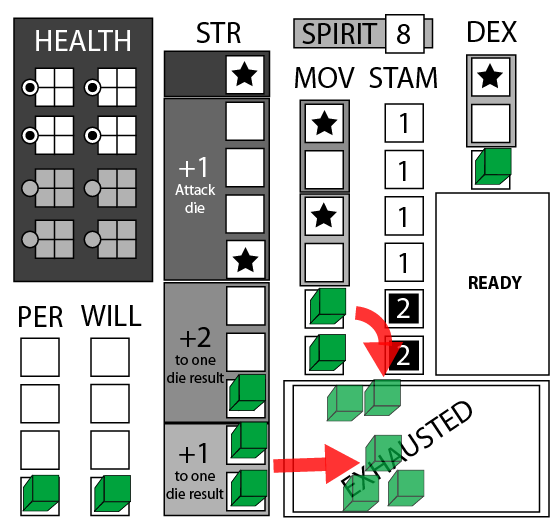
During the your turn, you spend the cubes to execute actions like the 2 cubes to move 2 units or the 3 STR cubes to attack an enemy. These cubes are then moved to the “Exhausted” zone.
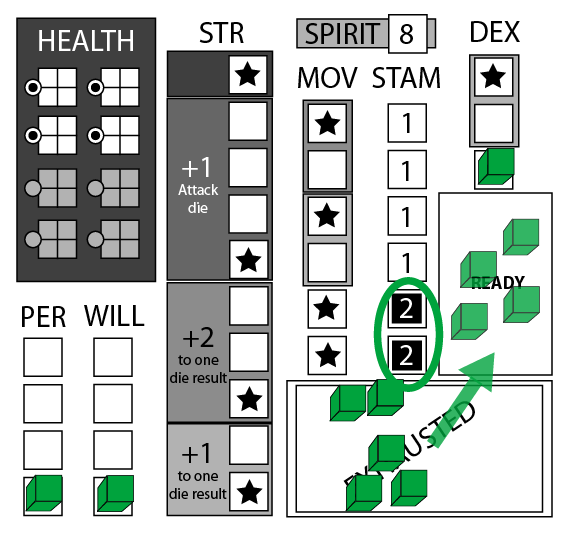
At the beginning of the next round, exhausted cubes then move back to the “Ready” zone to be allocated to your action options again. The number of cubes that get to move from the “Exhausted” zone is based on the STAM stat (Stamina). In the example above, the hero didn’t allocate any extra cubes to the stamina stat so he only gets four back. Spaces completely in back with numbers in white are treated as always active so the hero will always get a minimum of four cubes back. Allocating cubes to the STAM stat will pull more cubes out of the “Exhausted” zone and the cube allocated to STAM is not exhausted itself but goes straight to “Ready” at the beginning of the round. This is similar to trying to rest a little bit in the current turn to prepare for a larger active turn later.
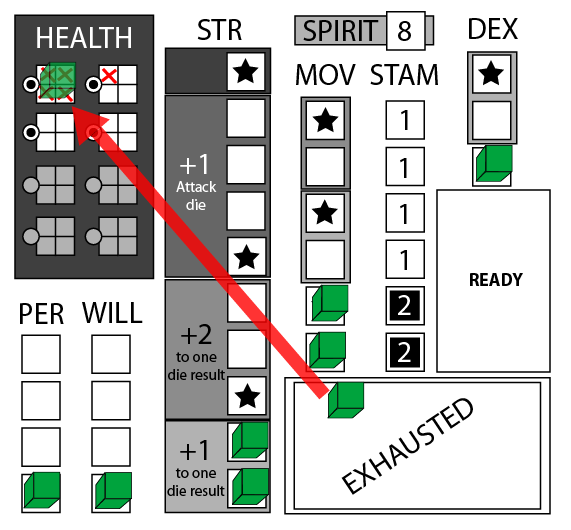
The last example I’ll show is how damage will also affect the hero. In the “Health” section, we see groupings of four-boxed spaces. Each little box is one damage the hero can take and when a four-box space is full, the hero immediately needs to pull one of his action cubes from the board and put it in the corresponding “Health” zone space. The circles to the side of each group indicate the active health of the hero for the battle (in this case, four groups or 16 total health). As the hero progresses, they may gain access to more of these spaces and have more overall health for the battle. During the battle, not only will the hero have to manage his action economy of resource use and stamina but also contend with the loss of permanent action cubes due to sustaining damage.
So there we have it, the action-allocation system completes a full cycle. This represents the basics of the core hero mechanics used to get your hero up and running, slaying monsters with guile. I’ve run through this system about a dozen times, tweaking things here and there as I find what is fun and balanced. I have a ways to go before I consider it locked in but I’m liking the game flow and this micro-management of the hero’s actions during the game. Later on we’ll discuss the flow of the turn itself and how monsters behave.
